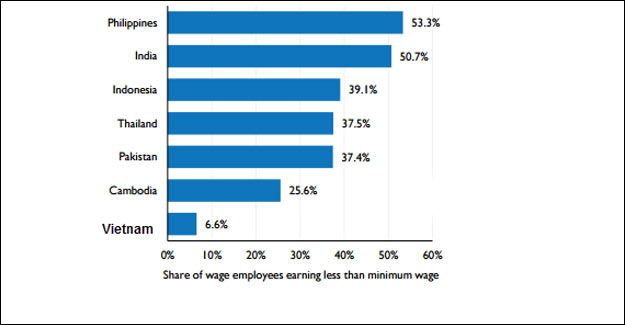
ILO: Vietnam Better At Compliance With Minimum Wage
Non-compliance with the minimum wage in Vietnam's garment, footwear, and textiles sector is the lowest among seven garment-exporting countries in Asia, according to a recent report from the International Labor Organization (ILO) on weak minimum wage compliance in Asia's garment industry.
Non-compliance rates in the sector range from 6.6-53.3%. Vietnam has the lowest non-compliance rate, of 6.6%. Cambodia, Pakistan, Thailand and Indonesia follow, with 25.6%, 37.4%, 37.5%, and 39.1%, respectively. The highest non-compliance rates were found in India and the Philippines, of 50.7% and 53.3%, or about eight times higher than in Vietnam. "Vietnam stands out, with a non-compliance rate in the single digits," the report stated. Meanwhile, more than one-third of garment sector workers in Indonesia, Thailand and Pakistan are paid below the minimum while around one in four Cambodian garment sector workers is paid below the minimum.
The report also revealed that women are more likely than men to be paid below the minimum wage in the garment sector in each of the countries. "This gender gap in compliance rates varies considerably between countries," the report noted. The largest male-female compliance gap is in Pakistan, with 86.9% of women in the garment sector being paid less than the minimum wage and 26.5% of men, for a gender gap of 60.4 percentage points in compliance rates.
"India, the Philippines, and Thailand also have double-digit gender compliance gaps, but these are much smaller than Pakistan's disparity," according to the report. "By contrast, in Cambodia, Indonesia, and Vietnam, the difference between non-compliance rates for men and women is relatively small," the report assessed. Vietnam's non-compliance rate for women is 5.7% percentage points higher than for men and only higher than the gap in Cambodia and Indonesia, of 4.4 and 4.6 percentage points, respectively. Regarding the depth of non-compliance, Vietnam is assessed as the country with the smallest percentage of garment workers being paid far below the minimum wage. It also has largest proportion of workers being paid far above the minimum wage."Minimum wages play a vital role in the garment and footwear sector, in which collective bargaining over wages is relatively rare," the report stated. Minimum wages can only achieve their fundamental purpose of giving wage earners necessary social protection against unduly low wages if workers are actually paid the legal minimum, it went on.
It urged policymakers and social partners to consider the design and implementation of the minimum wage-setting system and targeted compliance measures where appropriate.

Textile Excellence
If you wish to Subscribe to Textile Excellence Print Edition, kindly fill in the below form and we shall get back to you with details.








